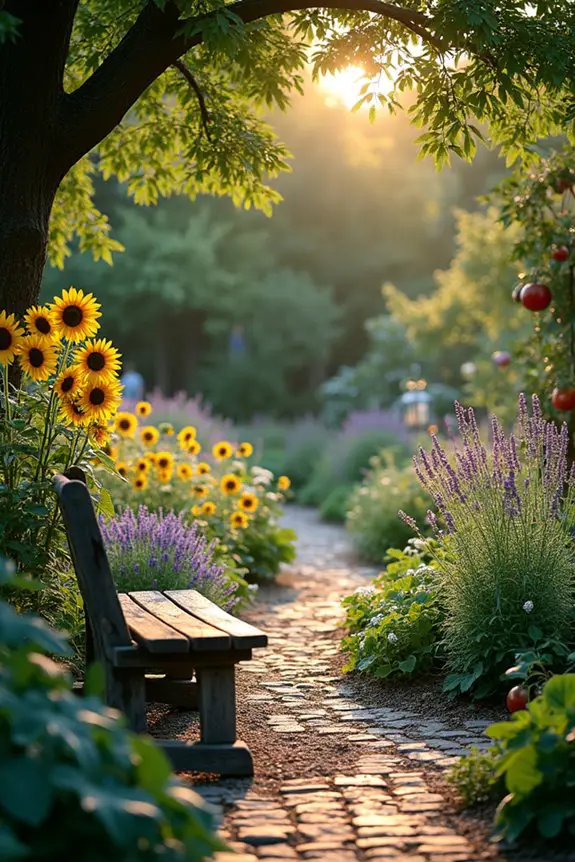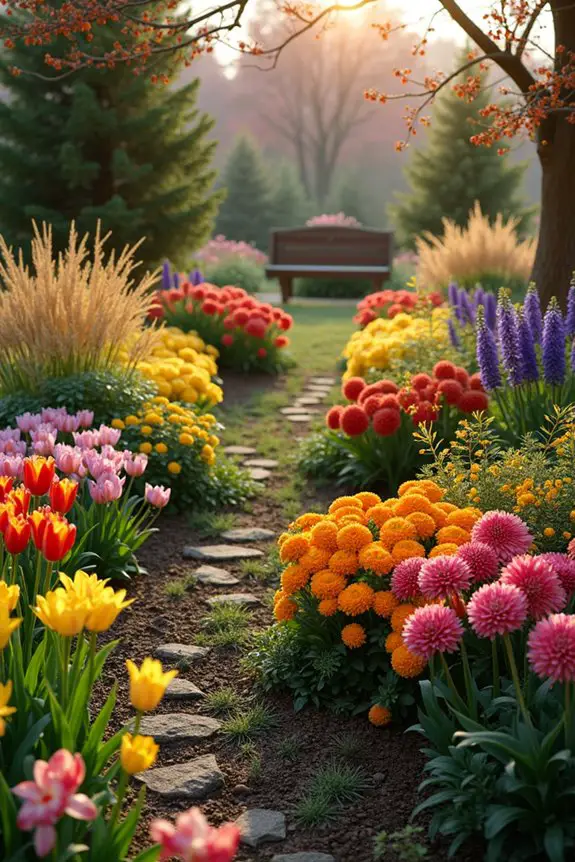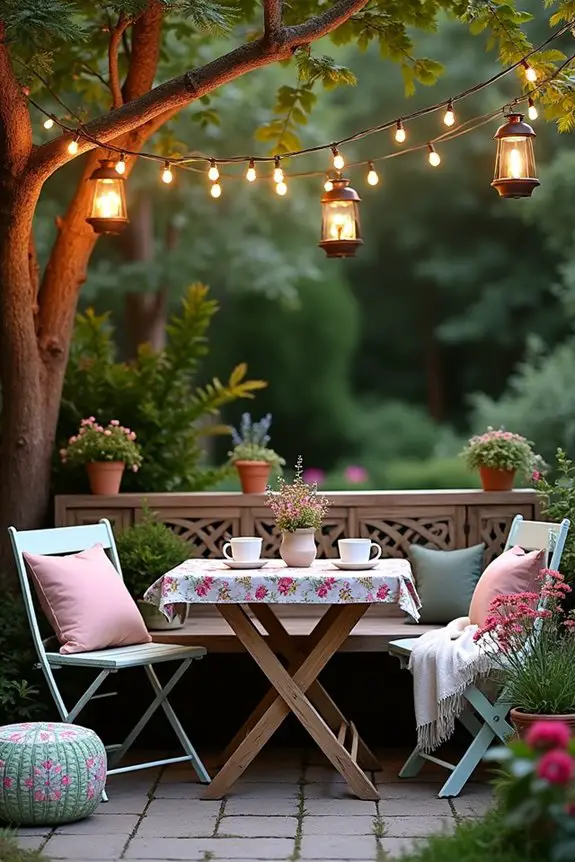Have you ever walked through a garden and felt like you were stepping into a painting? English gardens have this magical quality, blending beauty and comfort seamlessly. If you’re dreaming of your own slice of paradise, I’ve got some fantastic ideas to spark your creativity. Think cozy cottage vibes, colorful floral pathways, and even strategic plant arrangements. Stay tuned, because you won’t want to miss these inspiring tips that can transform your outdoor space into a true retreat.
Cottage-Style Garden Layouts
If you’re dreaming of a charming cottage-style garden, you’ve landed in the right spot.
Picture winding floral pathways that lead you to cozy seating areas, all while you select the perfect plants that practically sing in harmony.
You’ll want to think about how different textures and colors can bring it all to life—who knew gardening could feel this much like creating art?
1. Floral Pathway Arrangements
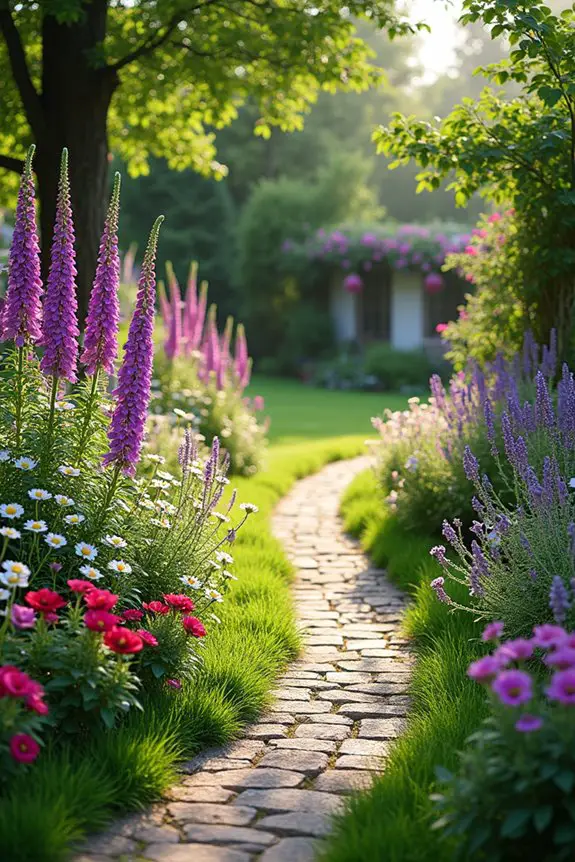
Creating a floral pathway in your garden isn’t just about aesthetics; it’s like painting a canvas with nature’s colors while directing your guests’ footsteps along a charming route. Envision this: vibrant blossoms guiding you through a garden that feels cozy and inviting. A cottage-style layout enhances that homey vibe, making every stroll feel like a step into a fairy tale. Trust me, even if you stumble now and then, it’ll feel like you’re tripping through a delightful adventure, not a garden walk.
To start, think about your pathway’s design. Curvy paths sweep like gentle ribbons across your lush lawn. Consider using reclaimed bricks or natural stones, which blend seamlessly with the earth—there’s something so satisfying about repurposing items, right?
Now for the fun part: selecting your flowers. Choose a mix of tall foxgloves and delicate daisies, combined with colorful geraniums. Make sure to plant them in clusters for that wild, overgrown look, like Mother Nature herself just tossed her bouquet here. It creates a whimsical feel, making you—and your guests—feel like part of something special.
When planning your plants, add variety in height and color. Low-growing ground covers like creeping thyme are great for filling the gaps between larger blooms. And don’t forget about fragrant herbs; think lavender or rosemary, which not only smell divine, but can also please your cooking endeavors. Just imagine snipping off a bit for that evening roast—I can tell you, it elevates your dish, even if the rest of the meal is, well, less than gourmet.
And here’s where it gets personal—I once tried to create this flowery path in my backyard, and let’s just say it looked fabulous in my mind. In reality? My neighbors might’ve wondered if I was going for the “let’s-see-how-many-weeds-can-be-planted-together” look.
But, with a little persistence and the right flowers—let’s be honest, more than a few trips to the garden center—I finally found my groove.
2. Plant Selection Strategies
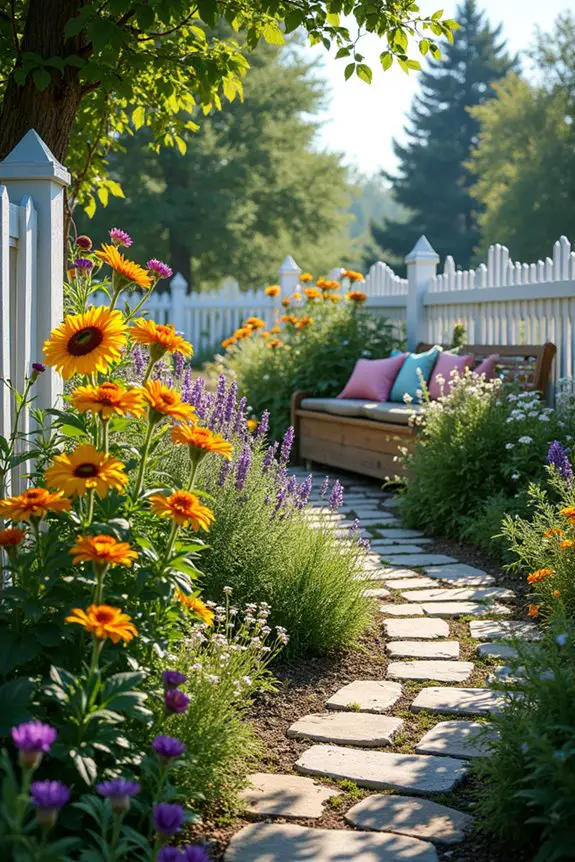
When it comes to creating a charming cottage-style garden, the selection of plants is key. It’s about more than just filling up space—it’s about crafting a whimsical yet functional retreat that feels like an extension of your home. Plus, the right plants can add layers of color, texture, and even scents that transform your outdoor space into a little slice of paradise.
Start by thinking about the personalities of the plants you want. Tall sunflowers stand proudly next to cheerful marigolds, while luscious peonies droop gracefully, their petals spilling like a gentle waterfall. It’s all about mixing unique shapes and shades to create visual interest, both for you and your visiting pollinators. Imagine the delight of your friends and family as they stroll through your garden oasis, greeted by joyful blooms at every turn.
Consider seasonal diversity, too. You want to guarantee your garden doesn’t just dazzle in the summer, but can also hold its own in the fall and spring. Planting a mix of early bloomers like crocuses and late showstoppers like asters keeps things lively all year long. You don’t want a garden that goes bare and sad like a forgotten sandwich in the back of the fridge, right?
And let’s not overlook herbs. As you curate your plant selections, think culinary! Rosemary, sage, and thyme can fill your space with delightful aromas, plus they’re great for tossing into your dishes. You might be imagining a gourmet meal made from the produce you nurtured right outside your door—though let’s be real, if that roast chicken turns out bland, at least your garden will still smell incredible.
Then there’s the practice of grouping similar plants together. Think clusters rather than a random soup of colors. This creates a more cohesive look that’s easy on the eyes—like a well-organized spice rack. Using a quality bulb planter tool can help ensure that you plant your bulbs at the right depth and spacing, promoting healthy growth. Additionally, utilizing a transplanting trowel garden can facilitate precise planting and minimize root disturbance for your favorite plants.
I learned this the hard way. In my first go at gardening, my flower choices looked like they were engaged in a loud debate rather than harmonizing beautifully. But with each mishap came clarity, and soon I was blending colors and heights with the confidence of a seasoned chef whipping up a signature dish.
3. Textural Layering Techniques
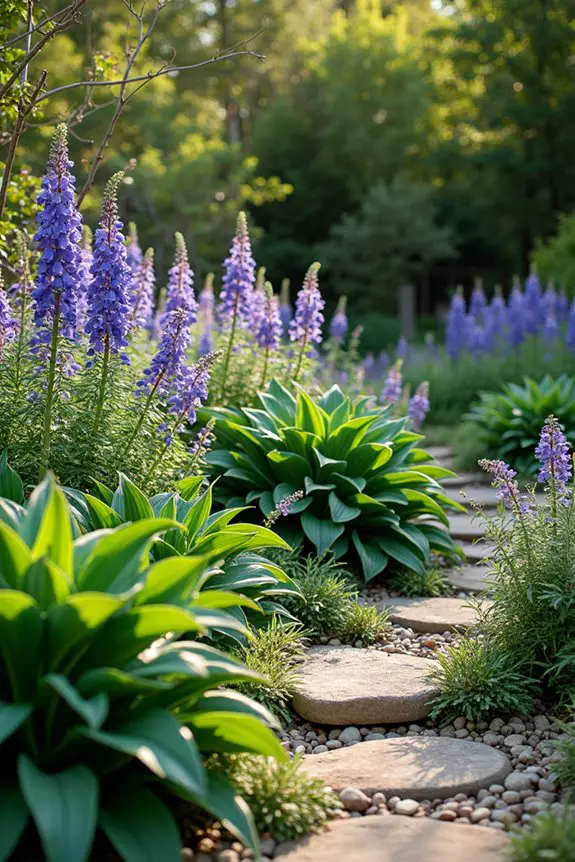
Creating an enchanting cottage-style garden is all about layering textures. Using a variety of plants with different leaf shapes, sizes, and surfaces adds depth to your garden, making it feel more inviting and cozy. Just like flipping through a cookbook, where each recipe’s texture lends a unique mouthfeel, your garden can achieve a rich, multi-dimensional look. To enhance your comfort while gardening, consider wearing a cooling neck gaiter to keep cool during warm days.
Start with a base of greenery. Think broad-leaved hostas, which offer a lush backdrop. Imagine those as your trusted vegetable stock—rich and satisfying.
Then, layer in plants with finer textures, like catmint and ornamental grasses, for a sprinkle of freshness. This combination creates a delightful contrast and draws the eye, much like the crispness of a fresh salad next to a velvety soup.
Don’t forget to play with heights. Taller plants, like delphiniums, should stand tall like proud pasta in a spaghetti dish, making space for shorter drapery plants like creeping thyme to spread out below.
With careful planning, your garden can take on a multi-tiered look that’ll have folks feeling like they’ve stumbled upon a hidden treasure. A hand rake can be an essential tool for maintaining garden textures, ensuring that your layers remain well-defined and aesthetically pleasing.
Also, mix in some bare branches or decorative stones. Think of these as seasoning that ties the whole dish together. They’re the crunchy bits that add nuance and interest, breaking up the softer spots with character.
When I first started gardening, I skipped this step, and my garden felt like a flat pancake—nice, but lacking that delicious meaning.
Once I added textural variety, my yard transformed into a bustling, vibrant space where life thrived.
4. Color Palette Selection
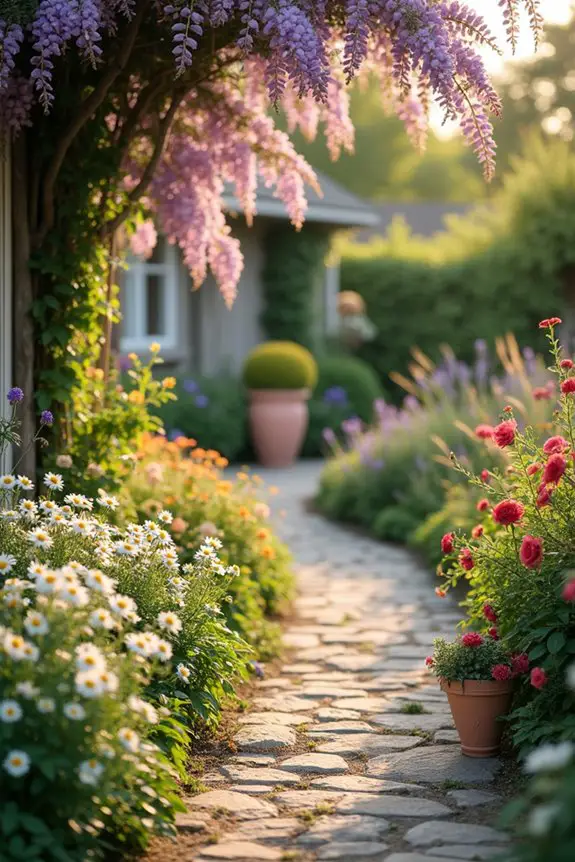
When it comes to designing a cottage-style garden, selecting the right color palette is like choosing the perfect seasoning for your dish. You want to create a harmonious blend that’s both inviting and lively. The right colors can evoke feelings of warmth, nostalgia, and joy—all essential for that cozy cottage vibe.
Start with a foundation of soft, earthy tones—think sage greens, buttery yellows, and gentle creams. These colors mimic the natural elements around you, giving your garden that organic feel. Just like a fresh loaf of bread, these foundational hues are comforting and essential.
Then, sprinkle in some pops of color—vibrant purples, radiant reds, and cheerful pinks. These bright shades are the cherry on top of your sundae; they keep things exciting and playful. You might think of these as the unexpected zests in a classic recipe, adding that little something that catches the eye and makes your garden feel alive.
Don’t forget about the seasons! Layer your colors to create interest throughout the year. Early spring bulbs can provide a sneak peek of color, while summer blooms carry the show forward. By planning for seasons, your garden keeps evolving, like a slow-cooked stew that develops flavor over time.
And, remember, less can be more. Just like trying to balance too many flavors in a dish can lead to confusion on your plate, sticking to a cohesive color scheme will help maintain that charming cottage essence. Plus, consider placing your plants in ceramic plant pots to add an extra layer of sophistication and style.
So take a cue from your favorite comfort food—but instead of overdoing it with spices, focus on what makes each bloom unique and vibrant in the larger garden composition.
In my experience, I once went overboard with too many contrasting colors, and boy, did it look like a rainbow threw up on my flower beds. A little editing, and a thoughtful palette transformed my space from chaos into a picturesque garden.
Trust me, finding that balance is key to a serene, welcoming courtyard.
5. Seating Area Integration
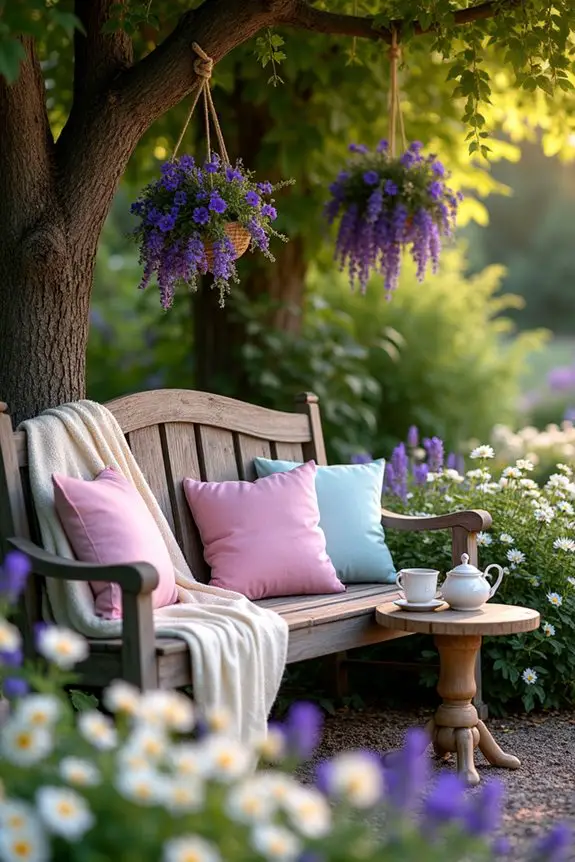
Creating a cozy seating area in your cottage-style garden is like adding a warm blanket to a chilly night; it just makes everything more inviting. Not only does it serve as a functional outdoor living space, but it also enhances the charm and whimsy that define this style.
Imagine sipping tea surrounded by blooming flowers and rustling leaves—a perfect little slice of paradise!
When planning your seating area, think about integrating natural materials. A weathered wooden bench or a wicker chair fits snugly into this environment, blending seamlessly with the lushness around it.
To kick it up a notch, consider a small table where you can enjoy snacks—or, let’s be real, your secret stash of cookies. Just remember, a seating area isn’t just furniture; it’s where memories are made, and laughter happens.
Placement is essential. Tuck your seating area into a nook or corner, where you can be part of the garden without feeling swallowed by it. A hidden corner under a leafy tree or near a flower bed allows for privacy—perfect for those moments when you want to escape the hustle and bustle.
You can imagine yourself lounging, surrounded by blooms, listening to the gentle hum of nature.
Don’t be afraid to dress up your seating area, either. Toss on some colorful cushions or a snug throw blanket, and you’ll find yourself wanting to linger just a bit longer.
Plants and flowers can act like nature’s curtain, softening the space and giving it that enchanted garden feel. Try trailing vines or hanging baskets to frame your seating nook and make it feel inviting, like a cozy café you can escape to.
I remember when I first tried to create a seating area in my garden. Let’s just say it looked like I was attempting to set up a camping site instead of a quaint retreat.
After some trial and error, I realized that a few thoughtful touches—a good spot, comfy seating, and some lovely blooms—turned it into my favorite part of the garden.
6. Planting Bed Shapes
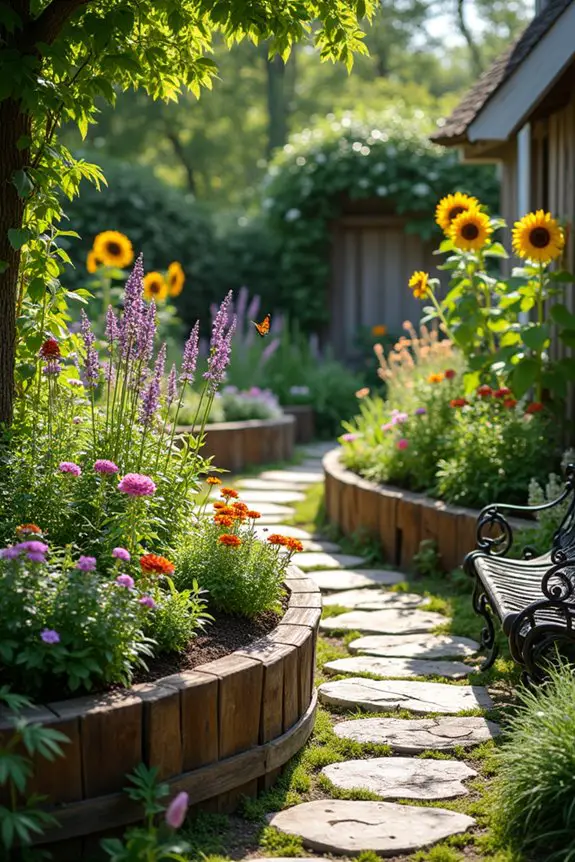
When it comes to designing a cottage-style garden, choosing the right planting bed shapes can truly elevate your outdoor space. The beauty of these gardens lies in their informality, so don’t be shy about adding some curves and angles to your layout. Think of it like creating an art piece—every twist and turn helps set the mood and makes the whole area feel alive.
One popular approach is to opt for raised beds, which not only add dimension to your garden but also make gardening tasks a lot easier on your back. Imagine reaching in to grab a handful of fresh herbs or colorful veggies without having to bend like a pretzel. Raised beds also help with drainage, providing a comfy home for your plants, so they’ll thrive more easily.
Now, don’t just stick with the usual rectangular shapes; play around with circles or meandering paths. Curvy beds can mimic the natural flow of the landscape and invite you to explore. Picture a winding garden path that leads you on an adventure, where every bend reveals a new surprise—a hidden patch of daisies or a splash of vibrant zinnias. You know that feeling when you find an old $20 bill in your coat? That’s what discovering a new flowerbed feels like!
In my own garden, I once tried creating a straight-edged rectangle only to realize it looked like a miniature parking lot. It took a little time to figure out how to design those beds with some curve, but wow, what a difference it made. Suddenly, my little plot transformed into a whimsical wonderland, where everything felt approachable, friendly, and, dare I say, a bit magical.
7. Vertical Garden Structures
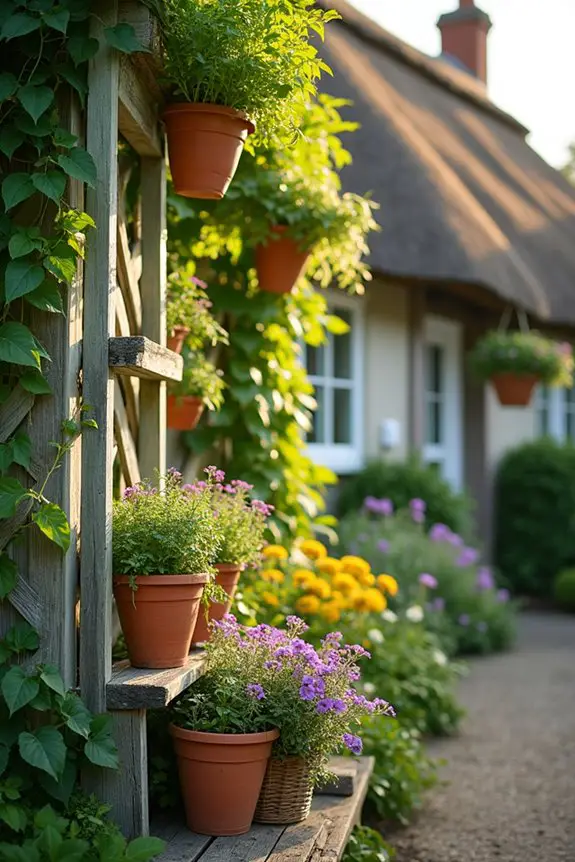
When you’re thinking about how to bring some height and personality to your cottage-style garden, vertical garden structures are a genius addition. Not only do they save space, especially if you’re working with a smaller backyard, but they also add layers of interest and surprise. Who doesn’t love a little drama in their garden, right?
Start with trellises—it’s like giving your climbing plants a stage to shine on. Peas, beans, and those gorgeous flowering vines will thank you. Just picture it: a lovely, leafy archway that beckons you to stroll beneath, perhaps trailing on a sunny afternoon.
To make it more enticing, consider adding fairy lights for an enchanting glow as the sun sets.
Then you have stacked containers—these beauties are a gardener’s best friend. They create vertical interest without needing to dig up a ton of ground. Just grab a few terracotta or even colorful plastic pots, stack them creatively, and fill with your favorite herbs or flowers.
Garden height? Check. Convenient snipping while you’re cooking? Double-check. I tried this once, and while I may have accidentally used the wrong type of pot and nearly toppled the whole thing, the end result was a charming herb tower that even my friends oohed and aahed over.
Lastly, don’t forget about hanging baskets. They can be placed at various heights—perhaps at eye-level for your towering sunflowers and higher up for delicate trailing varieties.
This adds movement and softness to hard structural points, blending everything together beautifully. What’s better than a surprise bloom right at your eye-line while you’re weeding? Talk about a little pick-me-up!
8. Garden Lighting Concepts
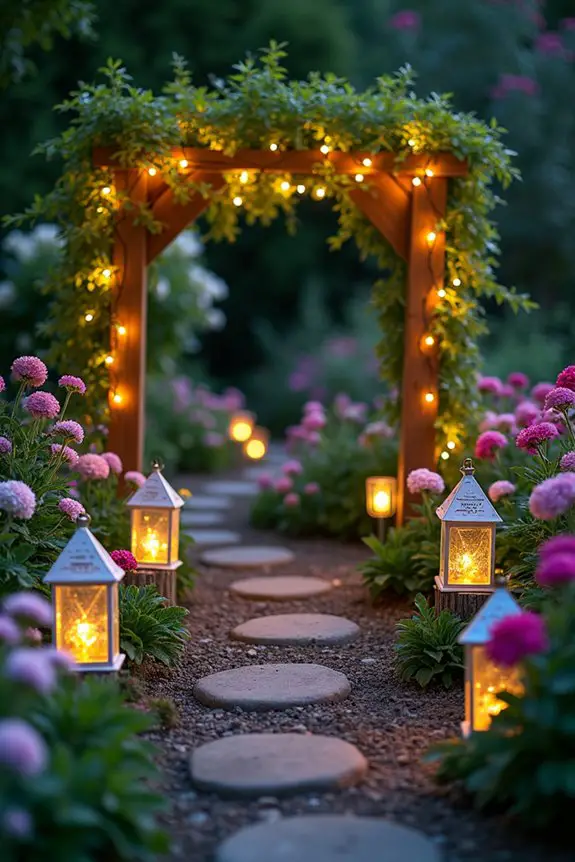
When it comes to creating a cozy cottage-style garden, garden lighting concepts can truly make or break the vibe. Imagine stepping outside in the evening and being greeted by soft, twinkling lights that dance through your garden like fireflies—pure magic, right? Not only do these lighting elements enhance the overall aesthetic, but they also provide essential functionality, allowing you to enjoy your garden long after sundown.
Start with string lights. Drape them across garden arches, along fences, or even weave them around shrubs. They create this whimsical atmosphere that makes you feel like you’re in a fairytale. And if you’ve ever tried untangling a ball of Christmas lights while simultaneously maneuvering around garden gnomes in the dark, trust me, you’re not alone.
Just grab some hooks, which you can often find at your local hardware store, and hang them securely. Voilà! Instant ambiance.
For a more grounded approach, consider solar lanterns sprinkled throughout your garden beds. They harness the sun’s power by day, offering a soft, gentle glow by night. Plus, they come in all shapes and styles—some look like adorable mini cottages—perfect for your theme.
I once tried using tea lights in mason jars and, well, let’s just say some of my herbs got a little scorched; those jars don’t come with a fire warning label. But with solar lanterns, you can avoid the mishaps and just enjoy the scene.
Don’t overlook fairy lights in glass jars either. These bring a touch of chic to your rustic garden setting. Just place them around as if you’ve invited tiny fairies to live among the flowers.
Every time I see the lights flickering, I can’t help but feel a little joy; it’s the little things that brighten our days, right?
Lastly, consider path lights to guide your way around the garden. They add safety while also highlighting the lovely plants you’ve worked so hard to grow.
Position them along walkways, ensuring they’re not too bright—no one wants to feel like they’re onstage in a spotlight. A soft glow is all you need to steer through those sleepy evening strolls while avoiding sneaky roots that could trip you up.
Let’s be honest, no one enjoys that surprise when you’re just trying to enjoy the beauty of your space.
Incorporating these lighting ideas not only creates a warm and inviting atmosphere but also turns your garden into a delightful place to gather with friends, sip some tea, and perhaps share a laugh or two about past gardening fails. Happy decorating and illuminating!
9. Garden Focal Point Ideas
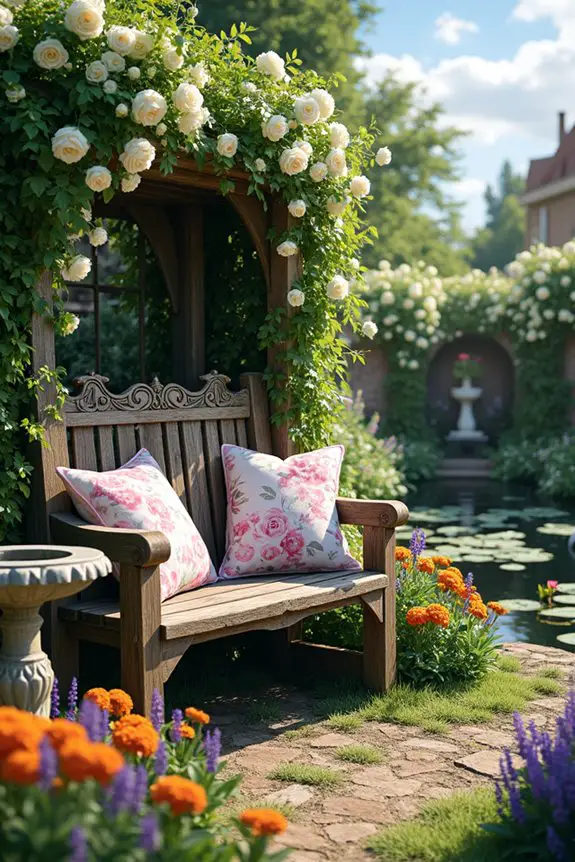
Creating a garden focal point is like giving your cottage-style garden a charming centerpiece that immediately draws the eye. Not only do these focal points enhance the overall beauty of your space, but they also add a touch of personality and warmth, inviting you and your guests to linger just a bit longer in your little paradise.
One popular option is to incorporate a classic wooden bench. Envision this: a weathered, rustic bench nestled among blooming flowers and lush greenery. It serves as both a place to rest and a stunning visual anchor. You might want to finish it with some comfy pillows or perhaps a cozy throw—just in case those chilly evenings sneak up on you.
Trust me, there’s nothing quite like sipping tea on your favorite bench while gazing at the stars.
Another delightful idea is a whimsical garden sculpture, such as a playful gnome or an elegant birdbath. These quirky additions can spark conversation and laughter, transforming your garden into a joyful retreat. I once placed a cheeky gnome next to my flowering pots, and let’s just say, he’s become a bit of a personality in the garden.
People ask about him all the time, and it’s always fun to share the stories of his “adventures.”
For a more natural touch, consider a trellis covered in climbing vines or flowers. This not only adds height to your garden but creates a beautiful backdrop that can change with the seasons. I love the idea of a climbing rose, producing fragrant blooms that entice butterflies.
Each spring, as they flourish, it’s like my garden is revealing a piece of art that’s forever evolving.
Lastly, if you’re feeling a bit ambitious (or slightly adventurous), how about creating a small pond? It doesn’t have to be anything grandiose; just a simple water feature can work wonders. Imagine the soothing sound of water gently bubbling or the fleeting glimpse of a dragonfly perched nearby.
I tried my hand at a mini pond once, and while it became an accidental fish sanctuary (my eternally curious cat was a bit too invested), it also served as a beautiful focal point that transformed the garden’s vibe entirely.
Incorporating one or two of these focal points blends functionality with charm. You’ll create a garden that not only looks good but feels amazingly inviting. Happy gardening!
10. Element Arrangement Strategies
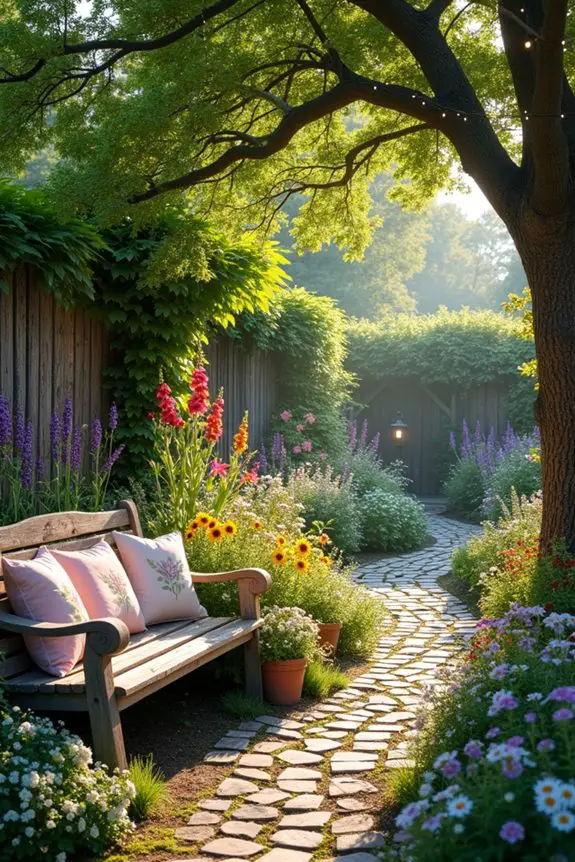
Arranging elements in a cottage-style garden is like painting a gorgeous landscape with nature’s vibrant colors. It’s about creating cozy nooks where you can sip lemonade, take in the sights, and breathe deeply while allowing your garden’s personality to shine through. The right layout not only enhances the beauty but also makes your garden more functional and inviting.
Start with your larger elements. Maybe that charming wooden bench we mentioned earlier could be positioned near a blooming flower bed, providing a welcoming spot for relaxation. Imagine this: you sit there, surrounded by swaying blossoms, while a gentle breeze carries the sweet scent of lavender. It’s all about creating a flow.
Leave some room for visitors to wander—a well-placed path made of bricks or stones can guide the way, inviting exploration. Just be sure to avoid making it look like a maze; you don’t want your guests to get lost like I did during my last garden party!
Next, think about layering. This is where height plays an essential role. Place taller plants, like sunflowers or hollyhocks, toward the back or the center, depending on your layout. Then, let the medium-height flowers, like daisies, fill in the edges, and finally sprinkle in some low-growing ground cover.
It’s sort of like creating a garden tier—it keeps the eye moving and makes each bloom stand out in its own spotlight. Honestly, I once threw caution to the wind and plunged into a haphazard arrangement. The mess I made resembled a kindergarten art project gone wild. Trust me, plan it out first!
Incorporate pathways that draw connections between different areas of your garden. Whether it’s a gravel path winding through vegetable patches or a simple wooden boardwalk leading to a small pond, these routes add adventure. Plus, they keep your shoes mud-free; because, let’s face it, no one wants to traipse through puddles while carrying freshly picked tomatoes.
Lastly, don’t forget those finishing touches. Hanging lanterns or twinkling fairy lights can create an enchanting atmosphere in the evenings. The soft glow adds a magical vibe, transforming your garden into a nocturnal retreat.
I went a little overboard with my lights one year and almost converted my garden into a Christmas wonderland—who knew my summer garden could take on a holiday flair?
All in all, remember that the key to a cottage-style garden is its inviting, laid-back charm. So take your time, arrange thoughtfully, and embrace the beauty of your little paradise. Happy arranging!
Maintenance Scheduling Best Practices
Even if you’re not a gardening expert, you can easily make your garden thrive by sticking to a solid maintenance schedule.
First, set aside time each week for essential tasks. Dedicate Saturdays to weeding, Sundays for watering, and maybe throw in some fish taco parties with your friends while pruning those rose bushes. Sounds fun, right?
Keep a garden journal to note when you plant your favorite english garden ideas; it’s a great way to track growth and blooms.
Don’t forget to check your soil every month – healthy dirt is key.
Healthy soil is essential for garden success; remember to check it monthly for optimal growth.
And hey, who doesn’t love to admire their handiwork?
With consistency, your garden will flourish, and you’ll feel like the proud ruler of your very own green kingdom.

